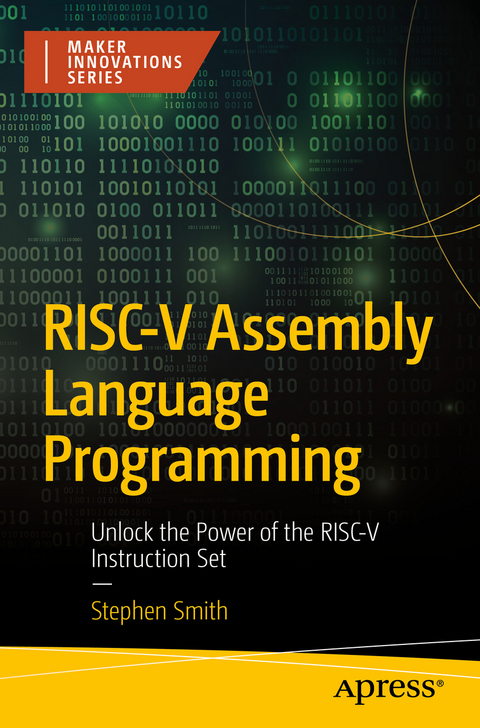
RISC-V Assembly Language Programming
Apress (Verlag)
979-8-8688-0136-5 (ISBN)
The RISC-V processor is the new open-source CPU that is quickly gaining popularity and this book serves as an introduction to assembly language programming for the processor in either 32- or 64-bit mode. You’ll see how to write assembly language programs for several single board computers, including the Starfive Visionfive 2 and the Espressif ESP32-C3 32-bit RISC-V microcontroller. The book also covers running RISC-V Linux with the QEMU emulator on and Intel/AMD based PC or laptop and all the tools required to do so.
Moving on, you’ll examine the basics of the RISC-V hardware architecture, all the groups of RISC-V assembly language instructions and understand how data is stored in the computer’s memory. In addition, you’ll learn how to interface to hardware such as GPIO ports. With RISC-V Assembly Language Programming you’ll develop enough background to use the official RISC-V reference documentation for your own projects.
What You'll Learn
Program basic RISC-V Assembly Language
See how data is represented and stored in a RISC-V based computer
Make operating system calls from Assembly Language and include other software libraries in projects
Interface to various hardware devices
Comprehend code containing Assembly Language
Reverse engineer and hack code
Use the official RISC-V reference documentation
Who This Book Is For
Those who have already learned to program in a higher-level language like Python, Java, C# or even C and now wish to learn Assembly Language programming.
Stephen Smith is a Software Architect, located in Gibsons, BC, Canada. He's been developing software since high school, or way too many years to record. He is an expert in Artificial Intelligence and Assembly Language programming, earned his Advanced HAM Radio License. Smith also enjoys mountain biking, hiking and nature photography, and volunteers for Sunshine Coast Search and Rescue. He is the author of Raspberry Pi Assembly Language Programming, Programming with 64-Bit ARM Assembly Language, and Mobile Devices and RP2040 Assembly Language Programming, all published by Apress. Also, he writes his popular technology blog, at smist08.wordpress.com.
Chapter 1: Getting Started. - Chapter 2: Loading and Adding. - Chapter 3: Tooling Up. - Chapter 4: Controlling Program Flow. - Chapter 5: Thanks for the Memories. - Chapter 6: Functions and the Stack. - Chapter 7: Linux Operating System Services. - Chapter 8: Programming GPIO Pins. - Chapter 9: Interacting with C & Python. - Chapter 10: Multiply and Divide. - Chapter 11: Floating-Point Operations. - Chapter 12: Optimizing Code. - Chapter 13: Reading and Understanding Code. - Chapter 14: Hacking Code. - Appendix A: The RISC-V Instruction Set. - Appendix B: Binary Formats. - Appendix C: Assembler Directives. - Appendix D: ASCII Character Set. - Appendix E: Answers to Exercises.
| Erscheinungsdatum | 14.02.2024 |
|---|---|
| Reihe/Serie | Maker Innovations Series |
| Zusatzinfo | 30 Illustrations, black and white; XXIV, 355 p. 30 illus. |
| Verlagsort | Berlin |
| Sprache | englisch |
| Maße | 155 x 235 mm |
| Themenwelt | Informatik ► Weitere Themen ► Hardware |
| Schlagworte | Assembly Language Programming • Python • RISC-V Architecture • RISC-V Optimization • RISC-V Processor • RISC-V Programming Tools |
| ISBN-13 | 979-8-8688-0136-5 / 9798868801365 |
| Zustand | Neuware |
| Haben Sie eine Frage zum Produkt? |
aus dem Bereich


